- June 24, 2022
- Posted by: Shane Daly
- Categories: Trading Article, trading psychology
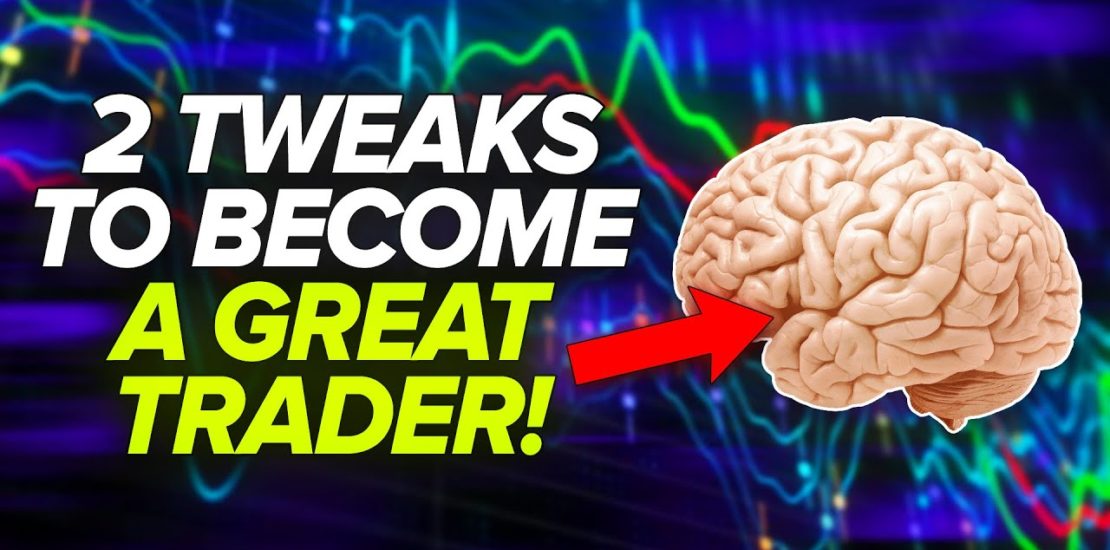
We have all heard and probably experienced that your mind can be the deciding factor in your trading success or failure. Some will go as far as saying that the edge you really have is yourself regardless of your trading system.
There are quite a few instances where the same method and same instructions were given to a group of people but the results were varied. That should give you pause to think that if you have a positive expectancy trading method and are not finding success, the issue just might be you.
How you look at losing trades, winning trades and even missing trades can sometimes make the difference between long term success or failure.
Trade Plan Is The GPS
If you have a trading strategy that has shown to have a positive expectancy, you can now look into other aspects of trading success. How you think and how you act will play a part in your success.
There are simple things you can do help combat the many psychological issues that arise when trading.
One extremely important one is to have faith in your trading system that in the end, after a steady stream of trades, the positive expectancy will deliver an up sloping equity curve.
To put it in a different perspective, let’s look at a driving analogy.
You know where you want to go and the GPS gives you precise directions to get there. It’s the same route you have taken many times in the past and even though you have arrived later due to traffic, you eventually meet your destination. What if during a busy weekend you decide to venture off the proven track due to congestion and decide to wing it. Not only that, but so sure that you knew your direction, you’ve decided to leave the GPS at home because after all, you’ve traveled it so many times before.
That’s what many traders do. They don’t get the results they want and in their impatience, start veering off the course into uncharted water. It rarely turns out well as they drain their capital and have to leave trading in the rear view mirror. They lose faith in their trading system and start doing things outside the scope of the tested trade plan they have been following. Some rectify this issue quickly and can salvage their capital so they can live to trade another day.
Others just quit.
Having a trading plan is a given and while most know they should have one, many don’t. That’s simply people not being prepared to treat trading as a professional career and statistics say that most traders fail. It’s obvious why.
2 Steps To Lighten The Load
I want to step outside the trade plan suggestion and dig into two things you can look at that may make it easier to loosen the grip psychology has on our trading.
Full Participation In Losing Trades – Limit Orders
You may have read that you should be definitive on your entry price and to let price come to you. For many people, they take this to mean they should use limit orders when looking to take a position in a market. This ignores that often times getting the best price is not the most important part of your trading method.
In fact, a popular saying goes something like “You make your money in the exits”.
You also save your money with the exits because if you don’t get out of a losing trade soon enough, you will watch your account tick away to nothing. The problem is that if you think an exact entry price is of the utmost importance and you are going to make sure you buy into an uptrend cheaply (flip for shorts), you may be adding a level of “angst” that will cause you issues in your trading.
I am going to assume that you already have a setup that you are looking at to actually have an entry price. In the following example, I am going to look at a support and resistance trader who places limit orders for the entry at the turns.
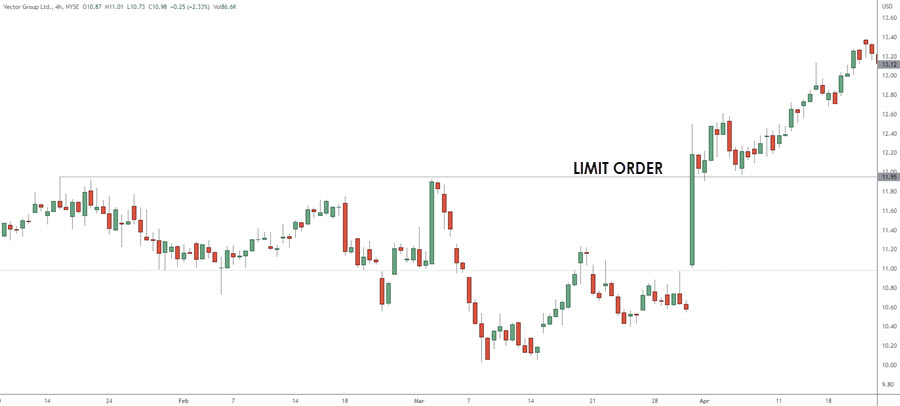
Price continues to put in lower lows and lower high and the trader marks off a resistance zone and places a limit order to short. Price rallies and breaks right through resistance, triggering the short trade. Depending on how this trader placed their protective stop loss, they could be immediately taken out.
Using limit orders, a trader will be fully involved in a losing trades when price triggers them in, and keeps going in the same direction.
While the hands off approach of limit orders may appeal to a trader, the risks may be unacceptable to many.
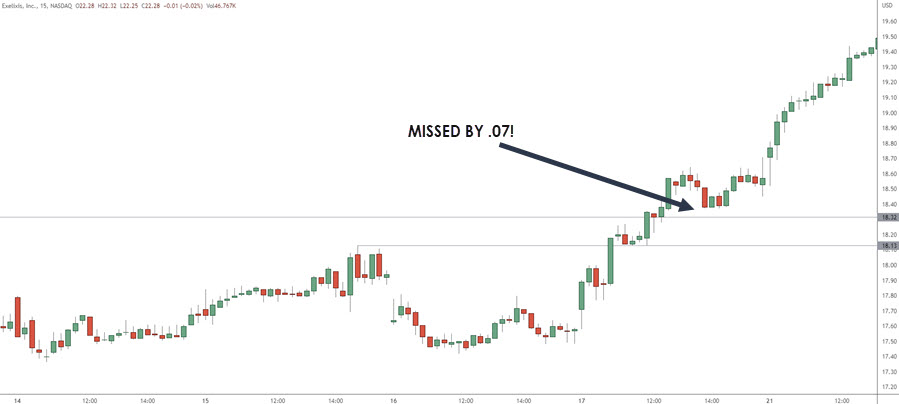
The same trader spots a breakout pullback trading opportunity. The limit order to buy is set and prices misses the entry price by a small margin. After taking a loss on the short trade and missing a 22% run in price, we can imagine the thoughts going through the head of this trader.
Enter The Stop Order
After a series of negative outcomes, the trader decides that trying to catch a turn that doesn’t exist is no longer a good strategy. Using an entry order that uses momentum in your direction ensures that, at least in the short term, the odds are in your favor.
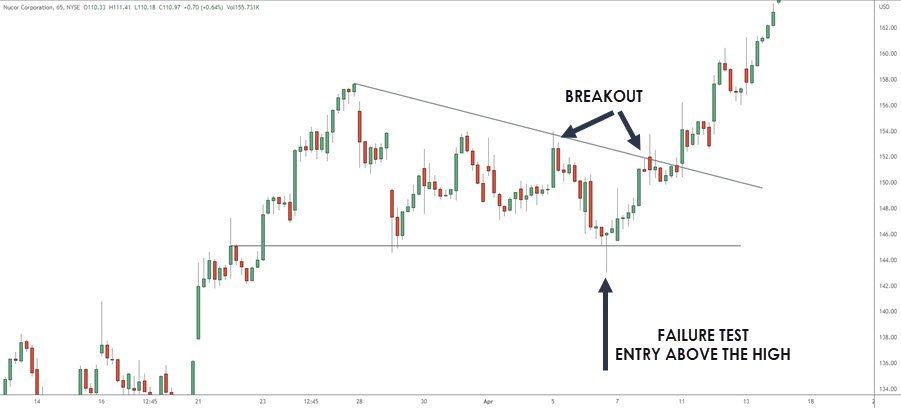
Price pulls back during an uptrend and the trader has 3 areas to enter. A failure test, when price probes below support and is rejected, gives an entry above the high of that candlestick. A trader can also use the breakout entry above the trend line or above the last swing high pivot. Keep in mind, this is not a breakout setup. It’s a pullback and using a breakout trade entry technique.
While there are no guarantees that price won’t collapse, the trader puts themselves in a good position as price was showing them a reversal could be underway. No more missed trades and no more instantaneous triggers and stop outs.
The main drawback for people is that price is moving away from your setup area and could result in a large stop distance which ends up in smaller position sizing. It’s a trade off but for my money, its a worthy one.
Taking The $$ Out Of Wins/Losses
This trading tweak comes from the idea of hiding your P/L (although this is not the tweak) until after the session is complete.
Why is that good advice?
Seeing the ticking up and down of a dollar figure can cause havoc with your trading mind. Think about seeing your position up $500 and then down $300. The constant wave of your profit amount can cause traders to exit out of a trade because of the difficulty of dealing with that. What is worse is when you attach something significant to a losing trade.
Imagine taking a loss of $1500 and then saying that you just lost the equivalent of your mortgage payment.
This tweak is from Van Tharp who encourages taking the dollars out of wins/losses and looking at them in terms of R (the Risk in a trade).
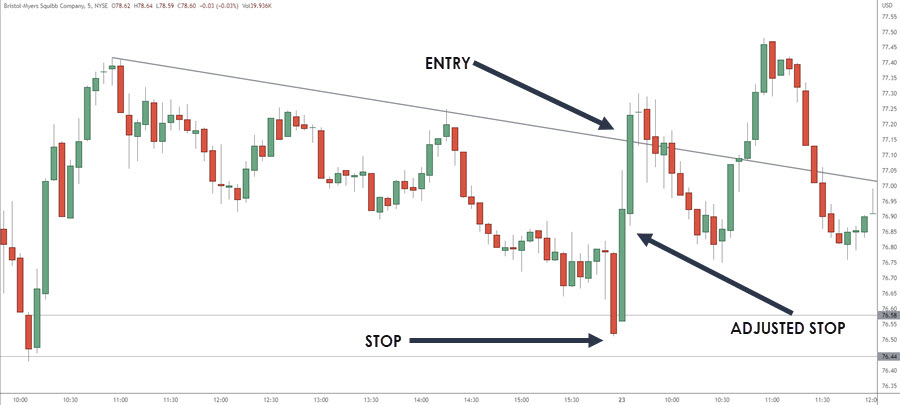
If you took this trade, you see a small profit begin to evaporate. Since price is not acting as you expected, you adjust your stop loss. If taking a full loss is -1R (1 X Risk), you are now taking a -.5R loss.
From a psychology standpoint, saying you took a $300 loss has a greater impact than logging a -.5R loss (half of your full risk) even though it’s the same.
Semantics? Maybe. There is a reason why Van Tharp takes this approach and does it with winning trades as well.
In this example, we have an ascending triangle with basing under resistance. A trader enters inside the base and the stop is placed under the base.
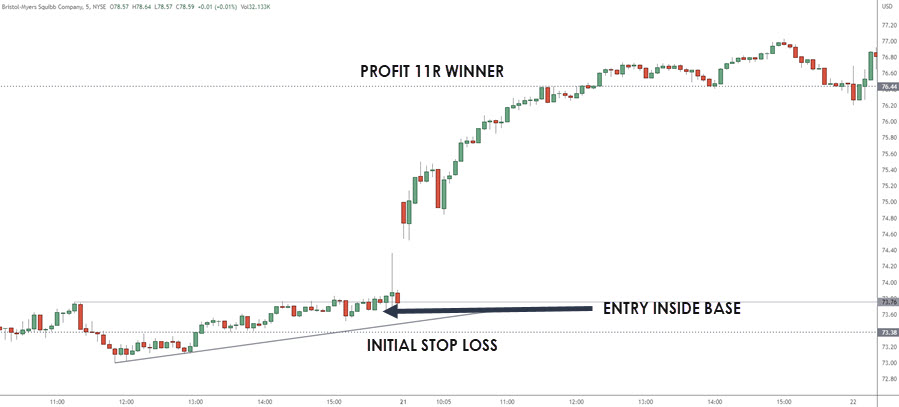
Price heads to their profit target for $3.00 per share win however the trader looks at is as a 11R winner ( 11 X Risk).
Is it a small thing? Perhaps. But I challenge you to approach your wins and losses in this manner.
Any Edge Is An Edge
You certainly want a trading method with an edge but to leave your edge concern there is misguided. Trading is not just about the method you trade but also how you process information including your wins, losses and of course opportunity missed. As traders, we want to make things as smooth as possible especially when we know that how we think about trading can influence our decision making process.
Allowing price to move in your direction allows you rest knowing there was some gains in your position. It also can allow you to adjust your stop loss if price is not acting as expected.
Not using a dollar figure in describing wins/losses is, without question, a huge step in not being swayed by comparing the dollar figure to other financial responsibilities.
Details matter and although these are small trading tweaks, they can have a positive effect on your performance and I challenge you to put these to use for the next month. See if you don’t look at things a little differently in the end.
